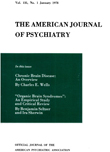A STUDY OF THE INFLUENCE OF EXPERIMENTAL DESIGN ON CLINICAL OUTCOME IN DRUG RESEARCH
Abstract
Examination of the research designs in 34 published papers (35 separate studies) dealing with the chlorpromazine treatment of chronic, hospitalized schizophrenic patients, reveals the following:
1. Those studies which included within their structure the double-blind, placebo-controlled technique showed significantly lower clinical improvement rates than those which did not.
2. No significant relationship was found between the various dosage levels used and clinical improvement rates, nor could a differential in dosage levels between single- and double-blind studies be established.
3. Long term studies showed significantly higher clinical improvement rates than did short term studies, demonstrating that duration of therapy, as well as degree of "blindness," may be a very meaningful variable in determining clinical outcome.
4. Duration of therapy was significantly related to degree of "blindness" in that only 1 of 11 double-blind studies was long term and only 4 of 16 single-blind studies were short term.
5. Long term, single-blind studies showed appreciably higher clinical improvement rates than did short term, double-blind studies. The very meager number of long term, double-blind studies (1 only) and, to a lesser extent, of short term, single-blind studies prevented us from differentiating between degree of "blindness" and duration of therapy regarding their relative impact on improvement rates. Thus, no clear-cut, certain evidence could be adduced either to support or nullify the contention that the double-blind, placebo-controlled method is, per se, a necessity for the "accurate" clinical evaluation of a drug. Further research and experimentation on this problem are urgently needed.
6. Considering improvement rates as a reflection of the observer's subjective attitude toward a drug, and using publication dates as a rough index of the chronological order in which the studies were performed, we were unable to demonstrate a general decline in improvement rates with the passage of time. Thus we could not validate the commonly held belief of a progression from an initial overenthusiasm to a later realism in the subjective evaluation of a drug.
7. Running like a thread through many of our results was the apparent importance of duration of therapy in determining improvement rates. This is one variable which, in particular, must be taken into account in any study of the relative scientific efficacy of the double-blind method.
Access content
To read the fulltext, please use one of the options below to sign in or purchase access.- Personal login
- Institutional Login
- Sign in via OpenAthens
- Register for access
-
Please login/register if you wish to pair your device and check access availability.
Not a subscriber?
PsychiatryOnline subscription options offer access to the DSM-5 library, books, journals, CME, and patient resources. This all-in-one virtual library provides psychiatrists and mental health professionals with key resources for diagnosis, treatment, research, and professional development.
Need more help? PsychiatryOnline Customer Service may be reached by emailing [email protected] or by calling 800-368-5777 (in the U.S.) or 703-907-7322 (outside the U.S.).



